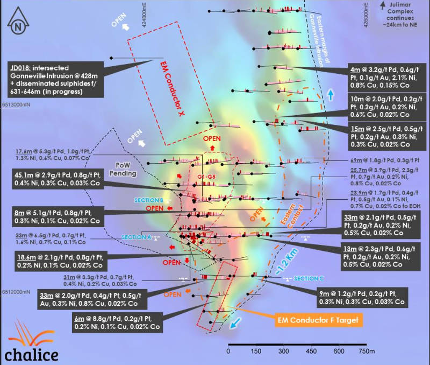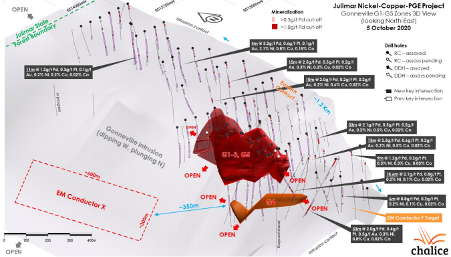Chalice’s Julimar “Much larger than originally thought ” as new opportunities emerge

Pic: Getty Images
Special Report: Latest findings from ongoing step-out and resource drilling at the Gonneville Intrusion set to propel growth
The significant discovery of platinum group element (PGE)-copper-gold came from ongoing exploration activities at the 100% owned Julimar-Nickel-Copper-PGE Project located approximately 70km north-east of Perth.
Chalice Gold Mines Limited (ASX: CHN) reported results from 5 new diamond and 22 new RC holes with a further 32 drill holes still pending.
Managing director Alex Dorsch said: “The Gonneville PGE-Nickel-Copper-Cobalt discovery continues to grow and, based on our recent drilling, the Gonneville intrusion now appears to be significantly larger than we originally envisaged, with a lot of room to grow towards the north-west.”
“We are continuing to discover exciting new target horizons some distance from the main high-grade zones delineated to date. New mineralised zones are emerging on the eastern contact of the intrusion with initial wide-spaced PGE and associated copper-gold drill intersections.
“And we haven’t even touched the newly defined, multi-kilometre long EM targets to the north within the Julimar State Forest.”
Prior to Chalice’s discovery, the Julimar Complex had never been explored for Nickel-Copper-PGE mineralisation. However two potential ‘feeder’ zones were identified by Chalice within the Julimar Complex as areas of interest – one being the Gonneville Intrusion where the most recent encouraging results were found, and the second situated mid-way along the Complex within the State Forest.
Findings at Gonneville
Those encouraging results centred around intersections at two key sites.
Several wide PGE-Copper-Gold intersections at the eastern end of the intrusion, covering a 1.2km strike length returned 33m at 2.1 grams per tonne (g/t) palladium, 0.5 g/t platinum, 0.2 g/t gold and 0.5 percent copper from 81m depth, as well as 15m at 2.5 g/t palladium, 0.5 g/t platinum, 0.2 g/t gold and 0.3 percent copper.
Another intersection at the southern end of the intrusion found 33m at 2.0 g/t palladium, 0.4 g/t platinum, 0.5 g/t gold and 0.8 percent copper, and 18.6m at 2.1 g/t palladium and 0.8 g/t platinum.
“The discovery of more extensive mineralisation along the eastern contact and at Conductor ‘F’ is another exciting step-change in our understanding of this large mineralised system, opening up an exciting new growth opportunity some 200-500m from the high-grade discovery area,” said Alex Dorsch.
The early results from Conductor ‘F’ were particularly noteworthy with the above findings coming from an initial drilling program of 20 drill holes (18 RC and 2 diamond), on a nominal 100m x 80m spaced grid.

High-Grade Zones of Mineralisation
Further to the promising Gonneville results, recent diamond drilling and geological interpretation had determined the presence of at least five high-grade zones (G1-G5) of mineralisation.
“At least five high-grade zones around the discovery area are now defined over approx. 550m of strike and up to approx. 340m of dip extent. Our geological understanding of the high-grade zones continues to be improved as we start to infill in parallel to step-out drilling,” Dorsch said.

The initial drill test of EM Conductor ‘X’ is also underway, a significant ~800m step-out hole currently at a depth of 690m. The hole has successfully intersected the Gonneville intrusion from 428m, and disseminated sulphide mineralisation from 631m to 646m, a highly encouraging result.
Looking Forward
Julimar is set to remain a primary focus for Chalice with an approach of simultaneously exploring and evaluating the region for high grade PGE-Nickel mineralisation and extensive zones associated with disseminated sulphides.
An initial drill test of EM Conductor ‘X’ has already commenced with further drilling to occur in the down-dip of the G1-G5 zones, once permitting approvals are received.
Chalice have also instigated a 70,000m RC/diamond drill program with two RC and two diamond rigs. Drilling was initially undertaken across an 80m x 80m spaced grid within the high-grade areas. A third RC rig is expected to mobilise the site in the coming weeks.
Metallurgical testwork on 200kg of composite samples are being compiled on various mineralisation styles within the intrusion. Once completed, the next phase of testing will begin focusing on flotation of fresh sulphide mineralisation and oxidative leaching of oxide mineralisation.
Geochemistry and geophysical work will also continue, with Chalice engaging the services of the Geological Survey of WA and a specialist consultant to conduct initial analysis and metallogenesis studies. Chalice hopes to further enhance its understanding of what has been discovered and what could potentially be uncovered across the large holding in the West Yilgarn Ni-Cu-PGE Province.
For Managing Director Alex Dorsch, the potential works suggested growth was set to continue through 2021. “The flow of drill results will continue as we step-up activity again with a fifth rig arriving shortly.”
“We are on track to meet the mid-2021 guidance for a maiden Mineral Resource and continue to prioritise growth of high-grade mineralised zones.
“It is exciting to see our Julimar discovery essentially reshaping the exploration landscape in WA. We have discovered what looks to be a new district within an entirely new province that stretches from the south-west of WA right up to the Midwest region. This is a game-changer for us and potentially for the entire industry. It’s very exciting times.”
This article was developed in collaboration with Chalice Gold Mines Limited, a Stockhead advertiser at the time of publishing.
This article does not constitute financial product advice. You should consider obtaining independent advice before making any financial decisions.

UNLOCK INSIGHTS
Discover the untold stories of emerging ASX stocks.
Daily news and expert analysis, it's free to subscribe.
By proceeding, you confirm you understand that we handle personal information in accordance with our Privacy Policy.








